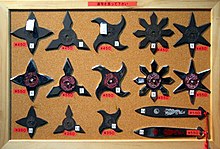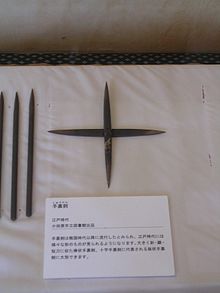Shuriken
A shuriken [ ɕɯ.ɺi.keɴ ] ( Japanese手裏 剣shuriken , hidden hand blade) is a short Japanese throwing weapon . In common parlance, they are also known as throwing or ninja stars , although they come in many different forms. In popular culture, these weapons are considered trademarks of the ninja . It is unclear whether this idea is historically correct.
use
According to tradition, the shuriken were carried in hidden pockets in the jacket or in the hakama (trouser garment, breeches ); Bo-Shuriken were held like pens in the back flap of the hakama or in the obi (belt, sash). There are known ways of carrying shuriken in loops or even strung on a pin in the obi.
Shuriken can become a very dangerous weapon in the hands of a skilled thrower. The throwing distance is a few meters, depending on the nature of the object to be thrown and the ability of the thrower, in order to enable a stabilized, controlled impact.
Sometimes poisons or horse manure were applied to the blades in addition to the cutting or stabbing effect , so that the opponent, if he survived the direct injury, usually died of poisoning or infection or at least fell ill. Most of the time, however, the Shuriken were used to stop a pursuer, so that he instinctively sought protection from the hail of throwing equipment that the ninja in question hurled at him.
Manifestations
There are different versions:
- Star-shaped flat (車 剣sha-ken , "wheel blade", or 平 手裏 剣hira-shu-ri-ken , "flat shuriken"). Different sizes and star shapes, three to eight points.
- Star-shaped. Round cross-section, no cutting edges. only sharpened.
- Bolt-shaped ( Bo-Shuriken ). Square in section with a pointed spot .
- Blade-shaped. Normal knife shape.
Weight, blade shape and design vary depending on the production and ryu (school, style).
Star-shaped projectiles
Disc and star shaped throwing blades often have a hole in the middle. According to tradition, coins with a rhombus-shaped hole were thrown in battle in medieval Japan . Blades with hole openings produce a high-pitched buzz or whistle when in flight, depending on the size of the hole, which confused the opponents because they did not know where the blades came from.
Other models
Shaken and Bo-Shuriken were thrown in bundles or individually. Targets were sensitive, unprotected areas such as the face, neck or upper body in order to create a painful distraction. The moment of distraction could then be used to gain an advantage - be it that the person to be hit tried to evade in order to protect himself or was physically restricted by the hit. Various Japanese fighting techniques teach you to flee after throwing or - taking advantage of the advantage - to continue the fight with a sword technique .
Legal regulations
Germany
Since April 1, 2003, throwing stars have been prohibited by law in Germany. Whether the ban only applies if the throwing stars are intended and suitable for harming health and are therefore not recorded as sports equipment is legally controversial.
Two short excerpts from the WaffG (German Weapons Act ):
- WaffG Annex 2 (to Section 2 Paragraphs 2 to 4) List of weapons
- Handling the following weapons and ammunition is prohibited:
- ...
- 1.3.3 star-shaped targets which, by their nature and handling, are intended to be thrown at a target and are capable of damaging health (throwing stars);
"Handling" within the meaning of this law is:
- WaffG §1 Subject and purpose of the law
- (3) Anyone who acquires, owns, surrenders, carries, spends, takes, shoots, manufactures, processes, repairs or trades with a weapon or ammunition deals with a weapon or ammunition.
Austria
The Austrian Arms Act is very liberal on this. However, if objects are considered to be war material, they are considered prohibited weapons according to the Weapons Act. In the past, shuriken have already been subject to judicial confiscation in order to counteract their specific danger.
Switzerland
In Switzerland, according to Art. 4 of the Weapons Act, Shuriken fall into the category of "devices intended to injure people". Acquisition and wearing in public are prohibited, but not possession.
literature
- Michael Finn: Art of Shuriken Jutsu. Paul Crompton, UK, 1983.
- Billy Hammond: Shuriken jutsu: The Japanese art of projectile throwing. AELS, Japan, 1985
- Eizo Shirakami: Shurikendo: My study of the way of Shuriken. Paul H. Crompton, London 1985
- Chikatoshi Someya: Shuriken Giho. Airyudo, Japan, 2001
- Chikatoshi Someya: Shuriken-Jutsu Nyumon. 1980
- Chikatoshi Someya: Shuriken. 2001
- Yasuyuki Ôtsuka: Shuriken Jutsu no Susume. 2004
- Wolfgang Ettig: Shuriken, the throwing stars. H. Velte, Sport-Buch-Verlag, 1982, ISBN 978-3-923473-00-7 .
Web links
Individual evidence
- ↑ Bernd Heinrich , in: Munich Commentary on the Criminal Code, 2nd edition 2013, § 2 WaffG, Rn. 14th
- ↑ Austrian Weapons Act 1996, Section 3 §17 (Source: http://www.iwoe.at) /
- ↑ RIS Justice; Legal sentence number RS0082019



